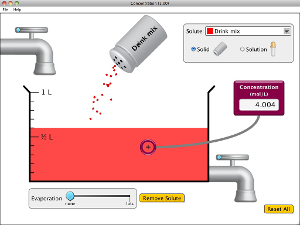|
|||||||||||||||||||||||
|
Help keep PhET free! Individual donations bring science to kids in your town and around the world. So please consider:
All donations are tax deductible. Thanks for your support! See our PhET
|
PhET's New "Sponsor-a-Simulation" Program
Do you know a company who wants to invest in educating our next generation? For companies or organizations interested in supporting STEM education, we have a new "Sponsor-a-Sim" program where they can pick a simulation to sponsor. If you know someone who might be interested, please contact Kathy Dessau. More details are at phet.colorado.edu/files/sponsor-info.pdf. Thanks! Featured Sims:Concentration
Fluid Pressure and Flow
Check Out These Other New Simuations:
Meet Our Emily Moore:
What do you do for PhET? I have two main objectives with the PhET project. The first is to lead the development of chemistry simulations for middle school and college classrooms. The second objective is to research effective use of the PhET simulations. Both require lots of creativity and collaboration, so I get to work closely with all of the PhET team members and with teachers and students across grade levels.How do you see PhET helping teachers? The PhET simulations provide a tool that has designed-in support for students, while remaining flexible for the teacher. The sims can be used as a complement to any teacher's facilitation style, as a lecture demo or in student group work or assigned as homework. This built-in flexibility supports teachers, who are constantly adapting facilitation to the needs of their students, while also providing opportunities for teacher's to creatively use the sims. I love hearing the innovative ways teachers use PhET sims, within POGIL activities, coupled with clicker questions or even going "meta" with students, asking questions like "Why do you think that particular representation was used in the sim?".How do you see PhET helping kids? PhET sims are designed to be open, inviting, immediately engaging, safe places for student exploration. Kids get the opportunity to 'figure out' the sim, with no penalties for trying something 'wrong'. In fact, trying something that doesn't work out as expected in the sim often encourages kids to try more! This emphasis on 'sense-making' (hey, why didn't that work...oh, I get it, it's because...) rather than correct 'answer-making' can be a powerful experience for kids, and it turns out, this mirrors what scientists do. Scientists try all sorts of experiments that don't end up not working, and are constantly trying to make sense of why an experiment didn't work, which results in a deeper understanding when an experiment does work.Where do you see PhET going? Everywhere! All PhET simulations are a unique combination of interactivity and support, based on PhET design principles. This approach to sim design can be useful across many disciplines, so I see PhET continuing to expand into more disciplines and across K-16.What's your favorite sim, and why? Circuit Construction Kit is my favorite sim. I have had the opportunity of observing this sim being used in multiple classrooms, and the response is always the same. Students dig right in, light up light bulbs and figure out how to set batteries on fire. They talk about electron flow, energy, voltage and amps. When they're done, they can go home and tell their parents about how real batteries work, how real light bulbs light, what circuits are used for, and how much fun they had in science class. Awesome!Don't forget to join us on Facebook, Twitter and our Blog!Be the first to learn about new sims, new teacher activities, articles and newsletters. We'd also love to hear how you use PhET in your classrooms. Spread the word so PhET can go viral.... |
||||||||||||||||||||||
|
You received this e-mail because you signed up at our website or emailed us at phethelp@colorado.edu. To opt out of these newsletters, please click on this link: @UNSUBSCRIBE@ or copy and paste the text into your browser. PhET Interactive Simulations | University of Colorado 390 UCB | Boulder, CO 80309-0390 |
|||||||||||||||||||||||









